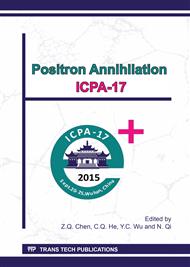[1]
J. Cizek, O. Melikhova, I. Prochazka, J. Kuriplach, R. Kuzel, G. Brauer, W. Anwand, T.E. Konstantinova, I.A. Danilenko, Phys. Rev. B 81 (2010) art. 024116, 19 pp.
DOI: 10.1016/j.vacuum.2007.01.036
Google Scholar
[2]
I. Prochazka, J. Cizek, O. Melikhova, J. Kuriplach, W. Anwand, G. Brauer, T.E. Konstantinova, I.A. Danilenko, I.A. Yashchishyn, in: B.N. Ganguly, G. Brauer (Eds. ), Near-Surface Depth Profiling of Solids by Mono-Energetic Positrons, Defects and Diffusion Forum 331, Trans. Tech. Pub., Zurich, 2012, p.181.
DOI: 10.4028/www.scientific.net/ddf.331.181
Google Scholar
[3]
I. Prochazka, J. Cizek, O. Melikhova, W. Anwand, T.E. Konstantinova, I.A. Danilenko, in: G. Murch, A. Öchsner, I. Belova (Eds. ), Diffusion in Advanced Materials, Diffusion Foundations 1, Trans. Tech. Pub., Zurich, 2014, p.155 – 172.
DOI: 10.4028/www.scientific.net/df.1.155
Google Scholar
[4]
I. Prochazka, J. Cizek, O. Melikhova, T.E. Konstantinova, I.A. Danilenko, Acta Phys. Polonica A 125 (2014) 760 – 763.
DOI: 10.12693/aphyspola.125.760
Google Scholar
[5]
I. Prochazka, J. Cizek, O. Melikhova, T.E. Konstantinova, I.A. Danilenko, I.A. Yashchishyn, J. Am. Ceram. Soc. 97 (2014) 982 – 999.
DOI: 10.1111/jace.12716
Google Scholar
[6]
I. Prochazka, J. Cizek, O. Melikhova, W. Anwand, G. Brauer, T.E. Konstantinova, I.A. Danilenko, J. Phys.: Conf. Ser. 505 (2014) art. 012020, 4 pp.
DOI: 10.1088/1742-6596/505/1/012020
Google Scholar
[7]
T. Konstantinova, I. Danilenko, V. Glazunova, G. Volkova, O. Gorban, J. Nanopart. Res. 13 (2011) 4015 – 4023.
DOI: 10.1007/s11051-011-0329-8
Google Scholar
[8]
F. Becvar, J. Cizek, L. Lestak, I. Novotny, I. Prochazka, F. Sebesta, Nucl. Instr. Meth. Phys. Res. A 443 (2000) 557 – 577.
Google Scholar
[9]
J. Kansy, Nucl. Instr. Meth. Phys. Res. A 374 (1996) 235 – 244. Information on www. positronannihilation. net.
Google Scholar
[10]
I. Prochazka, I. Novotny, F. Becvar, Mater. Sci. Forum 255 – 257 (1997) 772 – 774.
Google Scholar
[11]
M. Eldrup, D. Lightbody, J.N. Sherwood, Chem. Phys. 63 (1981) 51 – 58.
Google Scholar
[12]
K. Sudarshan, D. Dutta, S.K. Sharma, A. Goswami, P.K. Pujari, J. Phys.: Condens. Matter 19 (2007) art. 386204, 8 pp.
DOI: 10.1088/0953-8984/19/38/386204
Google Scholar
[13]
T.L. Dull, W.E. Frieze, D.W. Gidley, J.N. Sun, A.F. Yee, J. Phys. Chem. B 105 (2001) 4657 – 4662. R. Zaleski, M. Sokół, Mater. Sci. Forum 666 (2011) 123 – 128.
Google Scholar
[14]
K. Ito, Y. Yagi, S. Hirano, M. Miyayama, T. Kudo, A. Kishimoto, Y. Ujihira, J. Ceram. Soc. Japan 107 (1999) 123 – 127.
DOI: 10.2109/jcersj.107.123
Google Scholar
[15]
T.C. Hales, arXiv: math/9811071v2 (2002).
Google Scholar


